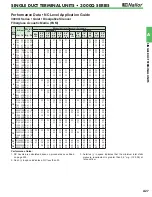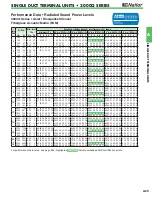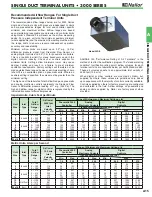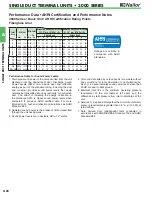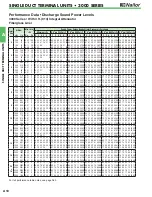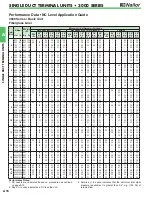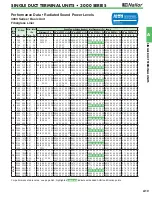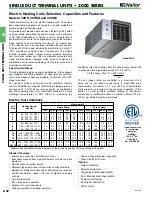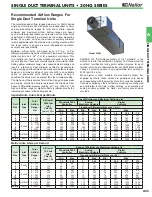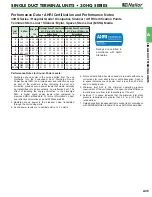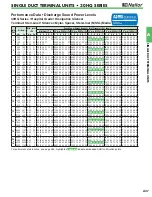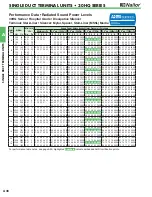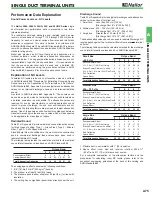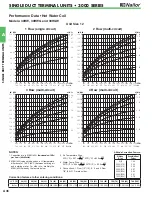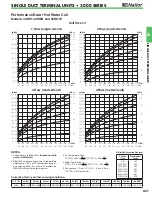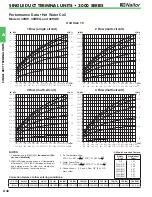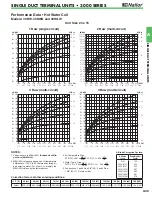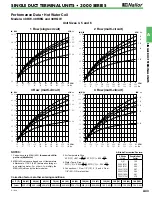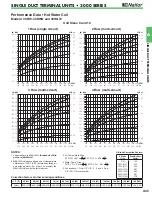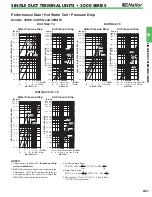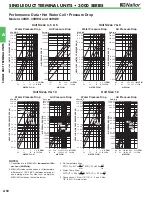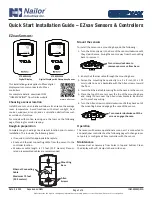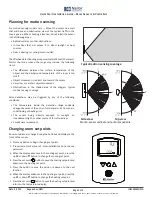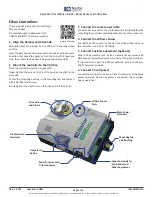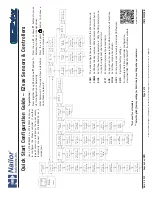
A75
SINGLE DUCT TERMINAL UNITS
A
SINGLE DUCT TERMINAL UNITS
Performance Data Explanation
Sound Power Levels vs. NC Levels
The
Nailor 3000, 3000Q, 30HQ, 30X and 30HQX Series
single
duct terminal unit performance data is presented in two forms
(where applicable).
The laboratory obtained discharge and radiated sound power
levels in octave bands 2 through 7 (125 through 4000 Hz) center
frequency for each unit size at various flow rates and inlet static
pressures is presented. This data is derived in accordance with
ANSI/ASHRAE Standard 130 and AHRI Standard 880. This data is
raw with no attenuation deductions and includes AHRI Certification
standard rating points.
Nailor also provides an NC Level table as an application aid in
terminal selection, which includes attenuation allowances as
explained below. The suggested attenuation allowances are not
representative of specific job site conditions. It is recommended
that the sound power level data be used and a detailed NC
calculation be performed using the procedures outlined in AHRI
Standard 885, Appendix E for accurate space sound levels.
Explanation of NC Levels
Tabulated NC levels are based on attenuation values as outlined
in AHRI Standard 885 "Procedure for Estimating Occupied Space
Sound Levels in the Application of Air Terminals and Air Outlets".
AHRI Standard 885, Appendix E provides typical sound attenuation
values for air terminal discharge sound and air terminal radiated
sound.
As stated in AHRI Standard 885, Appendix E, "These values can
be used as a quick method of estimating space sound levels when
a detailed evaluation is not available. The attenuation values are
required for use by manufacturers to catalog application sound
levels. In product catalogs, the end user environments are not
known and the following factors are provided as typical attenuation
values. Use of these values will allow better comparison between
manufacturers and give the end user a value which will be expected
to be applicable for many types of space."
Radiated Sound
Table E1 of Appendix E provides radiated sound attenuation values
for three types of ceiling: Type 1 – Glass Fiber; Type 2 – Mineral
Fiber; Type 3 – Solid Gypsum Board.
Since Mineral Fiber tile ceilings are the most common construction
used in commercial buildings, these values have been used to
tabulate Radiated NC levels.
The following table provides the calculation method for the radiated
sound total attenuation values based on AHRI Standard 885.
The ceiling /space effect assumes the following conditions:
1. 5/8" (16) tile, 20 lb/ft
3
(320 kg/m
3
) density.
2. The plenum is at least 3 feet (914) deep.
3. The plenum space is either wide [over 30 feet (9 m)] or lined with
insulation.
4. The ceiling has no significant penetration directly under the unit.
Discharge Sound
Table E1 of Appendix E provides typical discharge sound attenuation
values for three sizes of terminal unit.
1. Small box:
Less than 300 cfm (142 l/s)
[Discharge Duct 8" x 8" (203 x 203)].
2. Medium box: 300 – 700 cfm (142 - 330 l/s)
[Discharge Duct 12" x 12" (305 x 305)].
3. Large box:
Greater than 700 cfm (330 l/s)
[Discharge Duct 15" x 15" (381 x 381)].
These attenuation values have been used to tabulate Discharge NC
levels applied against the terminal airflow volume and not terminal
unit size.
The following tables provide the calculation method for the discharge
sound total attenuation values based on AHRI Standard 885.
1. Flexible duct is non-metallic with 1" (25) insulation.
2. Space effect (room size and receiver location) 2500 ft.
3
(69
m
3
) and 5 ft. (1.5 m) distance from source.
For a complete explanation of the attenuation factors and the
procedures for calculating room NC levels, please refer to the
acoustical engineering guidelines at the back of this catalog and
AHRI Standard 885.
Octave
Band
2 3 4 5 6 7
Environmental Effect
2
1
0
0
0
0
Ceiling/Space Effect
16
18
20
26
31
36
Total Attenuation Deduction
18
19
20
26
31
36
Small Box
Octave Band
<300
cfm
2 3 4 5 6 7
Environmental Effect
2
1
0
0
0
0
5 ft. (1.5 m) 1" (25) Duct Lining
2
6
12
25
29
18
Branch Power Division (1 outlet)
0
0
0
0
0
0
5 ft. (1.5 m), 8 in. dia. (203) Flex Duct 5
10
18
19
21
12
End Reflection
10
5
2
1
0
0
Space Effect
5
6
7
8
9
10
Total Attenuation Deduction
24
28
39
53
59
40
Medium Box
Octave Band
300 – 700 cfm
2
3
4
5
6
7
Environmental Effect
2
1
0
0
0
0
5 ft. (1.5 m) 1" (25) Duct Lining
2
4
10
20
20
14
Branch Power Division (2 outlets)
3
3
3
3
3
3
5 ft. (1.5 m), 8 in. dia. (203) Flex Duct 5
10
18
19
21
12
End Reflection
10
5
2
1
0
0
Space Effect
5
6
7
8
9
10
Total Attenuation Deduction
27
29
40
51
53
39
Large Box
Octave Band
>700
cfm
2 3 4 5 6 7
Environmental Effect
2
1
0
0
0
0
5 ft. (1.5 m) 1" (25) Duct Lining
2
3
9
18
17
12
Branch Power Division (3 outlets)
5
5
5
5
5
5
5 ft. (1.5 m), 8 in. dia. (203) Flex Duct 5
10
18
19
21
12
End Reflection
10
5
2
1
0
0
Space Effect
5
6
7
8
9
10
Total Attenuation Deduction
29
30
41
51
52
39

